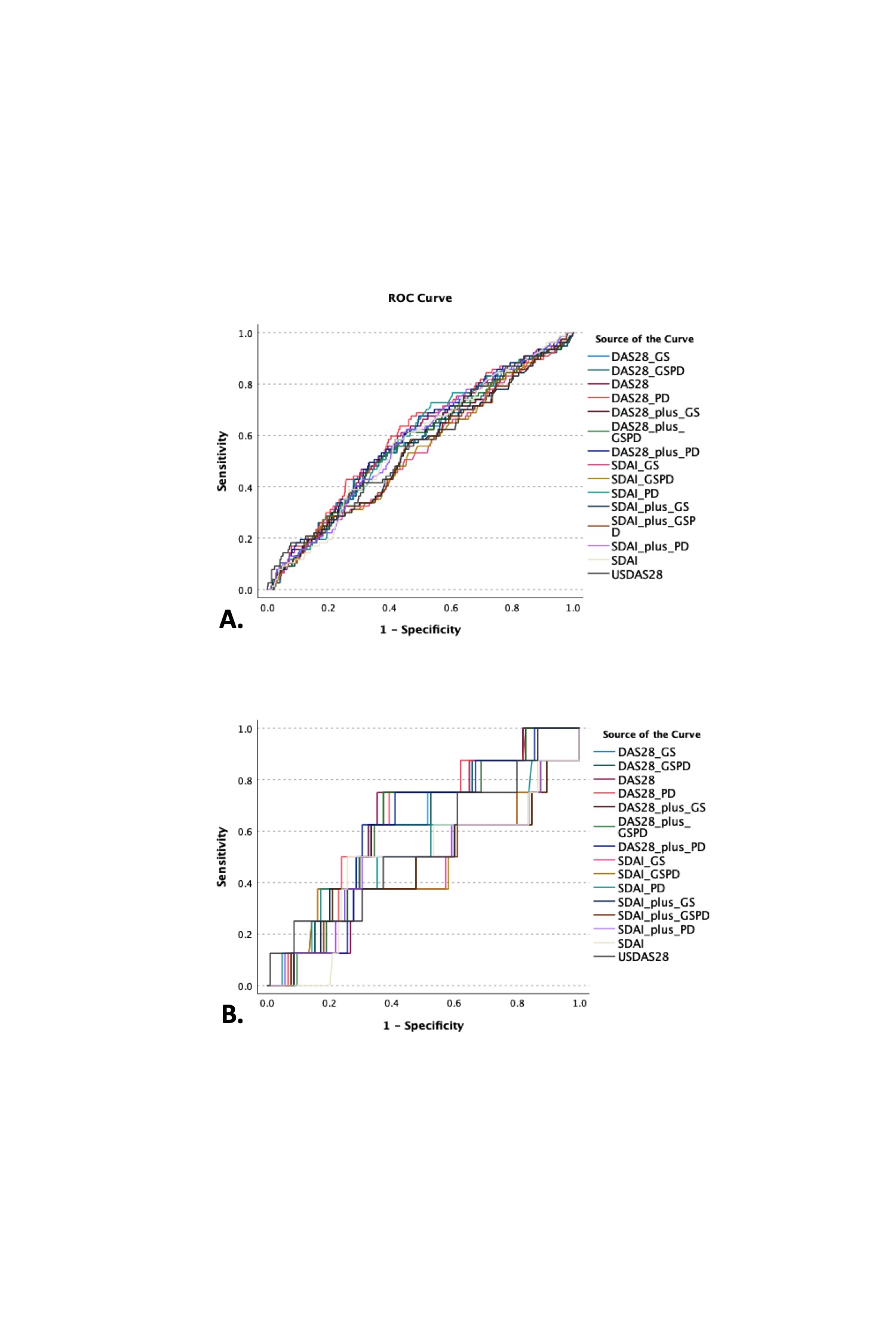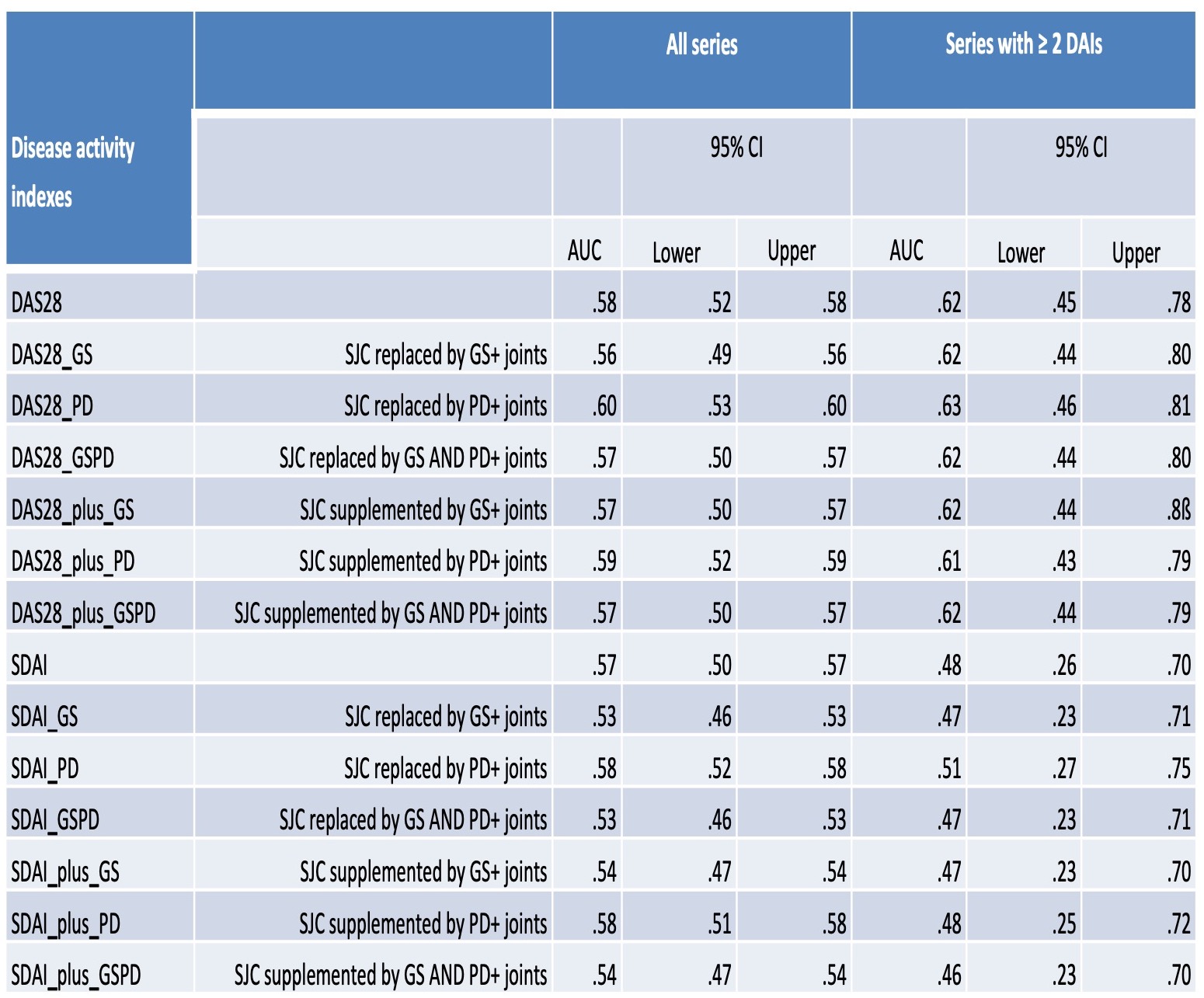Back
Poster Session C
Imaging
Session: (1228–1266) Imaging of Rheumatic Diseases Poster
1262: Clinical and Ultrasound-based Composite Disease Activity Indices and Radiographic Progression in Rheumatoid Arthritis
Sunday, November 13, 2022
1:00 PM – 3:00 PM Eastern Time
Location: Virtual Poster Hall
- DA
Daniel Aletaha, MD, MS, MBA
Medical University Vienna
Wien, Austria
Abstract Poster Presenter(s)
Irina Gessl1, Thomas Deimel1, Paul Studenic1, Giorgio Tamborrini2, Pascal Zufferey3, Daniel Aletaha4, Burkhard Moeller5 and Peter Mandl1, 1Medical University of Vienna, Vienna, Austria, 2Ultrasound Center and Institute for Rheumatology, Zürich, Switzerland, 3HFR, Fribourg, Switzerland, 4Medical University Vienna, Wien, Austria, 5Inselspital - University Hospital Bern, Bern, Switzerland
Background/Purpose: Musculoskeletal ultrasound (US) has been reported to predict radiographic progression in rheumatoid arthritis (RA). The aim of the study was to test the predictive value of composite disease activity indices (DAI) based on solely clinical as well as clinical and US (USDAI) information to predict radiographic progression in RA.
Methods: Data from the Swiss Clinical Quality Management (SCQM) database were extracted from patients with RA;
USDAIs were created based on previous publications (1) (Table 1). In summary, the disease activity score in 28 joints (DAS28) and the simplified disease activity index (SDAI) were modified by supplementing or replacing the clinical swollen JC with joints showing signs of power Doppler (PD) and/or grey scale (GS) synovitis. Series with two standard x-rays of the hands (difference ≥ 183 days) and ≥1 visit with clinical and US data in between were analyzed. Progression was defined as an increase of ≥6.27 points of the Ratingen-Rau x-ray score.
Receiver operating curve (ROC) analyses were used to assess predictive ability of every DAI for radiographic progression.
As a subanalysis, ROCs using the median DAIs of series with ≥2 DAIs between two x-rays were run. Clinical DAS28/SDAIs were compared to their respective USDAI counterpart with the highest area under the curves (AUC).
References:
1. Mandl P et al., Arthritis Care Res 2013
Results: We included 649 series in 475 patients. Progression was observed in 84/649 (12.9%) series. Mean difference between the x-rays was 27.6±18.0 months. Mean age was 56.3±12.7 years, 474/649 (73%) series were from female patients. There was no significant difference between the AUC of the ROC of SDAI vs. SDAI_PD (p=0.19) nor between DAS28 vs. DAS28_PD: (p=0.17) (Figure 1A, Table 1). Similarly, when analyzing only series with ≥2 DAIs (143 series) we observed no difference between the AUC of the ROC of SDAI vs. SDAI-PD (p=0.28) nor between that of DAS28 vs. DAS28_PD (p=0.23) (Figure 1B, Table 1).
Conclusion: The predictability of radiographic progression by disease activity measures was generally limited. The composite USDAIs containing sonographic JC were not superior for predicting radiographic progression compared to their clinical counterparts although there was a trend for higher predictive value for indices containing PD.
 Figure 1. Receiver operating characteristic (ROC) curve of clinical and ultrasound-based composite disease activity indices (A) overall and (B) for the subgroup with series with ≥ disease activity indices. DAS, disease activity score; GS, grey scale; PD, power Doppler; SDAI, simplified disease activity index.
Figure 1. Receiver operating characteristic (ROC) curve of clinical and ultrasound-based composite disease activity indices (A) overall and (B) for the subgroup with series with ≥ disease activity indices. DAS, disease activity score; GS, grey scale; PD, power Doppler; SDAI, simplified disease activity index.
 Table 1. Area under the curves (AUC) of receiver operating characteristic curves for the predictive value of the composite disease activity indices for radiographic progression. DAI disease activity index; DAS28, disease activity score for 28 joints; GS, grey scale; PD, power Doppler; SDAI, simplified disease activity index; SJC: swollen joint count; + positive
Table 1. Area under the curves (AUC) of receiver operating characteristic curves for the predictive value of the composite disease activity indices for radiographic progression. DAI disease activity index; DAS28, disease activity score for 28 joints; GS, grey scale; PD, power Doppler; SDAI, simplified disease activity index; SJC: swollen joint count; + positive
Disclosures: I. Gessl, Eli Lilly, Boehringer-Ingelheim, Gilead; T. Deimel, None; P. Studenic, AbbVie/Abbott; G. Tamborrini, None; P. Zufferey, None; D. Aletaha, Novartis, SoBi, Sanofi, Amgen, Lilly, Merck, Pfizer, Roche, Sandoz, Janssen, AbbVie; B. Moeller, None; P. Mandl, None.
Background/Purpose: Musculoskeletal ultrasound (US) has been reported to predict radiographic progression in rheumatoid arthritis (RA). The aim of the study was to test the predictive value of composite disease activity indices (DAI) based on solely clinical as well as clinical and US (USDAI) information to predict radiographic progression in RA.
Methods: Data from the Swiss Clinical Quality Management (SCQM) database were extracted from patients with RA;
USDAIs were created based on previous publications (1) (Table 1). In summary, the disease activity score in 28 joints (DAS28) and the simplified disease activity index (SDAI) were modified by supplementing or replacing the clinical swollen JC with joints showing signs of power Doppler (PD) and/or grey scale (GS) synovitis. Series with two standard x-rays of the hands (difference ≥ 183 days) and ≥1 visit with clinical and US data in between were analyzed. Progression was defined as an increase of ≥6.27 points of the Ratingen-Rau x-ray score.
Receiver operating curve (ROC) analyses were used to assess predictive ability of every DAI for radiographic progression.
As a subanalysis, ROCs using the median DAIs of series with ≥2 DAIs between two x-rays were run. Clinical DAS28/SDAIs were compared to their respective USDAI counterpart with the highest area under the curves (AUC).
References:
1. Mandl P et al., Arthritis Care Res 2013
Results: We included 649 series in 475 patients. Progression was observed in 84/649 (12.9%) series. Mean difference between the x-rays was 27.6±18.0 months. Mean age was 56.3±12.7 years, 474/649 (73%) series were from female patients. There was no significant difference between the AUC of the ROC of SDAI vs. SDAI_PD (p=0.19) nor between DAS28 vs. DAS28_PD: (p=0.17) (Figure 1A, Table 1). Similarly, when analyzing only series with ≥2 DAIs (143 series) we observed no difference between the AUC of the ROC of SDAI vs. SDAI-PD (p=0.28) nor between that of DAS28 vs. DAS28_PD (p=0.23) (Figure 1B, Table 1).
Conclusion: The predictability of radiographic progression by disease activity measures was generally limited. The composite USDAIs containing sonographic JC were not superior for predicting radiographic progression compared to their clinical counterparts although there was a trend for higher predictive value for indices containing PD.
 Figure 1. Receiver operating characteristic (ROC) curve of clinical and ultrasound-based composite disease activity indices (A) overall and (B) for the subgroup with series with ≥ disease activity indices. DAS, disease activity score; GS, grey scale; PD, power Doppler; SDAI, simplified disease activity index.
Figure 1. Receiver operating characteristic (ROC) curve of clinical and ultrasound-based composite disease activity indices (A) overall and (B) for the subgroup with series with ≥ disease activity indices. DAS, disease activity score; GS, grey scale; PD, power Doppler; SDAI, simplified disease activity index. Table 1. Area under the curves (AUC) of receiver operating characteristic curves for the predictive value of the composite disease activity indices for radiographic progression. DAI disease activity index; DAS28, disease activity score for 28 joints; GS, grey scale; PD, power Doppler; SDAI, simplified disease activity index; SJC: swollen joint count; + positive
Table 1. Area under the curves (AUC) of receiver operating characteristic curves for the predictive value of the composite disease activity indices for radiographic progression. DAI disease activity index; DAS28, disease activity score for 28 joints; GS, grey scale; PD, power Doppler; SDAI, simplified disease activity index; SJC: swollen joint count; + positiveDisclosures: I. Gessl, Eli Lilly, Boehringer-Ingelheim, Gilead; T. Deimel, None; P. Studenic, AbbVie/Abbott; G. Tamborrini, None; P. Zufferey, None; D. Aletaha, Novartis, SoBi, Sanofi, Amgen, Lilly, Merck, Pfizer, Roche, Sandoz, Janssen, AbbVie; B. Moeller, None; P. Mandl, None.

